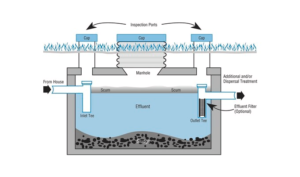Regular septic tank pumping prevents solid waste from flowing out into the soil absorption field and contaminating groundwater supplies. This protects the environment and enhances the value of your property.
Your septic tank resembles a big garbage can and is usually buried underground. Professional technicians locate it, remove the access lids or covers, and vacuum out sludge, scum, and liquid. Click the Septic Tank Pump Out Perth to learn more.

A well-maintained septic system can last a lifetime with proper care and pumping. Many homeowners don’t realize that septic systems have a lifecycle that requires regular attention, including pumping out the waste. They also tend to underestimate the amount of wastewater that flows through their drains each day. A professional septic tank service can help to keep your home’s drain system operating efficiently and prevent expensive repairs.
In addition to scheduling septic tank pumping services regularly, you should always pay close attention to early warning signs. These may include slow draining in the home, sewage backups in toilets and showers, and standing water or extra-green patches of grass near the leach field. If you notice any of these problems, they are an indication that it is time to schedule a septic tank pump out.
Septic tank pumping isn’t something that you can do on your own, as it requires specialized equipment to empty the tank and transport the waste. A professional can use a truck-mounted septic tank vacuum system to quickly pump out the waste and dispose of it at an approved disposal site. The process typically takes 2-3 hours based on tank size and waste volume. Many septic companies also offer a detailed inspection during the pumping process, checking for tank baffles and wall filters as well as looking at the drain field.
Having a fully functional septic system can make your property more attractive to prospective buyers. It can also reduce the number of pests attracted to your home by keeping them away from your drains. It is important to avoid flushing non-biodegradable items like paper towels, tissues, kitty litter, and feminine hygiene products into the septic system, as they can clog and kill the bacteria that treat your wastewater.
When choosing a septic tank pumping company, look for one with state licenses, insurance coverage, and certified technicians. You should also ask about the company’s service area and whether it provides any other septic services, such as filter cleaning or inspection. This can help to ensure that you get the best value for your money and the fastest response times.
Reduced Risk of Disease
A septic system collects wastewater and waste from multiple home sources, including toilets, showers, and sinks. The waste moves through pipes that lead to the tank and then drain into the leach field, where it is filtered by soil before it is absorbed into groundwater supplies. But when the tank isn’t pumped out regularly, solid materials can build up and enter the leach field, where they can cause disease. Regular pumping helps prevent these clogs and ensures that the bacteria in the tank can move through all the drains properly.
Septic systems come in a variety of styles, but they all work the same way. The septic tank stores waste until it is digested by the microorganisms and separates into liquid and sludge layers. The sludge layer is heavier and sits at the bottom of the tank, while the scum layer is lighter and floats on top of the liquid. The sludge and scum are removed during the pumping process, which also removes any accumulated grease.
Pumping services include a hands-on system inspection that can catch problems before they become major issues. Technicians locate and expose the access ports, then connect powerful vacuum equipment that safely pulls all the layers of sludge, scum, and liquid out of the tank. The job typically takes 2-3 hours based on the size of the tank and waste volume. Technicians examine the tank baffles and wall filters, and look for any problems in the drain fields. This visual inspection catches problems early, and it reduces future maintenance costs.
Although it’s possible to do some septic tank pumping and cleaning yourself, this is a task best left to the professionals. Licensed septic companies use specialized trucks that can handle dangerous gases and liquid waste. Trying to DIY the job can cost more in labor and equipment, and it can also result in contaminated water, code violations, and voided warranties.
Homeowners can reduce the need for frequent septic tank pumping by reducing the amount of solid waste they put into their drains. Cigarettes, left over medications, handwipes, paper towels, tissues, kitty litter, and other solids should go in the trash rather than the septic tank. Similarly, chemicals should be disposed of separately from household wastewater, and paint, varnish, solvents, and other liquids should never be flushed down the drains.
Reduced Water Bills
Keeping your septic tank in good condition reduces the demand for ground and surface water. This can help to keep your water bills lower. Depending on where you live, this may also help to protect local water supplies and wildlife.
While septic systems can last 40 or more years with proper care, they do need regular maintenance to function properly and safely. Regular septic tank pump out and inspections can reduce the need for costly repairs and prevent waste from backing up into your home.
Costs for septic tank pump out vary depending on the size of your tank, location, and other factors. Generally, smaller tanks require less frequent pumping. Larger tanks are more expensive to service due to higher labor rates and disposal costs. Buried or difficult-to-reach septic systems can add to the overall cost as well. Inquire about a specific price estimate when getting quotes.
Septic tanks are made of concrete or steel, and the type of material impacts tank durability and longevity. Concrete tanks typically last longer than steel tanks, but both types need to be pumped and inspected on a regular basis.
Solid materials settle to the bottom of septic tanks and form a sludge layer. Grease and other lightweight materials float to the top of the tank and are known as scum. Both sludge and scum need to be removed when the septic tank is pumped.
Regular septic tank pump out can prevent hardened waste layers from clogging drains and reducing the lifespan of your septic system. To make sure your septic tank stays healthy between pump outs, educate household members about appropriate waste disposal practices. Emphasize the importance of only flushing human waste, toilet paper, and safe food scraps down the drains.
When the septic tank is full, a pipe leads the liquid wastewater, called effluent, out of the tank to the soil absorption field. From here, gravity and bacterial action further treat the wastewater before it enters groundwater supplies. The septic tank helps to remove solid waste from the wastewater to prevent sludge from clogging and damaging the soil absorption field.
Reduced Maintenance
The saying “An ounce of prevention is worth a pound of cure” is especially true when it comes to your septic system. Regular septic tank pumping prevents the build-up of solid waste, which reduces the risk of a clogged septic system and costly repairs. It also keeps the septic tank in good working condition, which adds to the overall value of your home and yard.
Septic tank pumping may seem like a dirty, unpleasant experience, but the actual process only takes about 30 minutes to 1 hour. After locating the septic tank, and possibly digging to access it, a technician will use a large vacuum pump to suck up the liquid waste, solid waste, and sludge. After they’ve removed the contents of the septic tank, they’ll reexamine the system and replace the lid.
Solid waste in the septic system includes feces, slowly biodegradable organic solids such as toilet paper and cellulosic compounds, and non-biodegradable solids like kitty litter. Bacteria in the septic tank break down about half of these solids, but the other half accumulates. The resulting sludge settles to the bottom of the septic tank and floats the grease and lighter materials to the surface, known as scum.
Regular septic tank pumping helps keep the solids from building up in the septic system and prevents them from entering your drain field, where they can cause damage to your plumbing. Keeping the septic tank pumped out also reduces foul odors, which improves the indoor air quality in your home and makes your property more appealing to potential buyers.
A professional septic tank cleaning and pumping service can cost around $1,500 per septic tank. The exact amount will vary by septic tank size, how often you’ll need the service, and your home’s plumbing needs.

